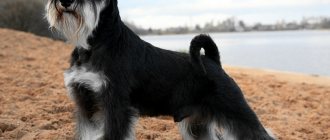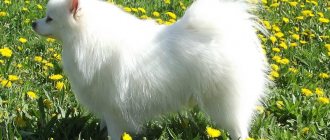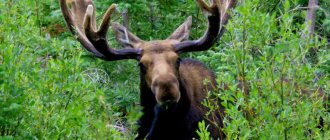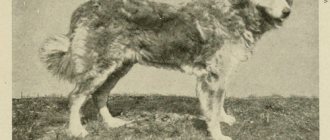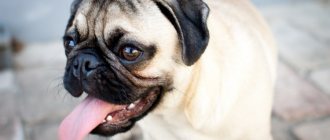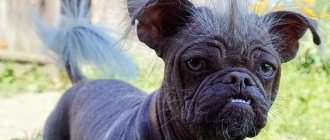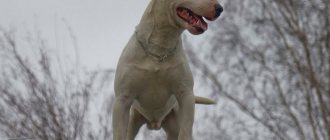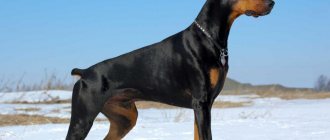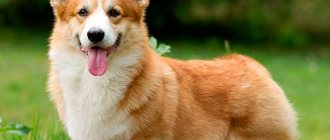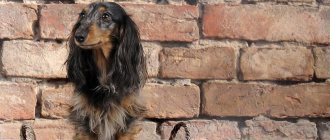- Pets
- >>
- Dog breeds
* Here is a photo of a typical representative of the Miniature Schnauzer dog breed . You can send us photos of your animals by email, and we will post them on the website. Don't forget to send your pet's name.
Other breed names:
Medium Schnauzer, Standard Schnauzer, Schnauzer
Description
Being a selective breed, schnauzers of different sizes have common features. The only difference is the sizes. There are three of them: small, medium and large.
The Schnauzer is a strong-looking, square-shaped dog. The back is slightly inclined at the sacrum.
The head appears massive due to the specific structure of the hair around the jaws and on the eyebrows. The muzzle is blunt, the transition from the nose to the forehead is clearly defined. The jaws are grasping and strong.
The ears are small and triangular in shape. Due to the fact that they hang on cartilage, until recently it was customary to dock them, just like the tail, which is curved towards the back.
The neck is strong. It smoothly transitions into a toned body. The sternum is well developed. The front paws are standard.
The Schnauzer has pronounced limb angles. This makes it possible to jump with ease and quickly trot with a flourish.
An active, cheerful dog easily endures bad weather. Wool with hydrophobic properties does not become very dirty. The specificity of the Schnauzer in the structure of the hair coat. It requires plucking. The undercoat is dense and does not shed. You will have to brush it almost daily.
According to the standard, it is customary to divide the color into black and “pepper and salt”. Any large spots of white shades are a sign for disqualifying the representative and sending the schnauzer puppy for culling, except for miniature representatives. Among them, more and more white dogs are appearing.
Popular colors of miniature schnauzers
Miniature Schnauzers have a thick, coarse coat of medium length and a good undercoat. Wavy and tousled fur is not allowed.
There are two types of coat color:
- Pepper and salt. With this color, each hair is colored with pepper, but the undercoat is gray. There is a dark mask on the muzzle;
- Black. The main hair and undercoat are colored pure black.
The two color types belong to the same breed, but the dogs are bred separately. The nursery breeds only one color. There are cases when individuals of only one color are presented at exhibitions.
Despite the fact that two colors are popular, owners give greater preference to the “pepper and salt” color. Therefore, the likelihood of seeing a Pepper Schnauzer on the street is much greater than a resin one. The calling card of the Miniature Schnauzer is its variegation. This color is recognized as the generic coat of arms of the breed.
The widespread distribution of peppered dogs was greatly influenced by the breeders themselves of this breed. So, pieds began to be bred in Russia ten years earlier than blacks. In addition, black Schnauzers did not have a wide choice of imported progenitors with strong roots.
Interesting fact: Despite the widespread distribution of peppered Schnauzers, it is the black representatives of this breed that are distinguished by their high class and can compete with foreign representatives of the breed.
Today, only two colors of Miniature Schnauzers are declared and no relaxation in this matter is expected from the registry section.
Origin story
The Schnauzer breed is descended from the Pinscher, which was previously known in two varieties: smooth-haired and wire-haired. Due to breeding work to select the working qualities of the best representatives of the breed, a completely new type has appeared. The literal translation of the breed means “muzzle with a mustache” or “mustachioed muzzle.” In essence, this is a new pinscher with a hard coat and improved breed characteristics.
The county of Bavaria is considered its homeland. There they were especially valued and used as:
- hunters of small rodents that damage farmers' property;
- security guards who quickly responded to extraneous noises, closely monitored what was happening and caught troublemakers;
- cattle drovers.
The result is a universal dog capable of performing many tasks.
The identification of larger representatives in the breed made it possible to use their natural strength to transport goods.
The formation of standard characteristics of the breed began relatively late, compared to the appearance of the Bavarian dog. Known since the Late Middle Ages. The elegance of the new breed attracted artists and sculptors. The genes of terriers and griffins are found in the blood of schnauzers, which explains their behavior.
The breed received its final appearance by the mid-19th century. At the same time, two colors were established: gray and black. By crossing representatives of the breed with a poodle and a German Spitz, both color combinations and three varieties were distinguished: small, medium, large.
At the Hanover Exhibition in 1879, first place was taken by a wire-haired dog of the same name, the modern name of the Schnauzer breed. This was the beginning of mass dog breeding.
Two decades later, in the first decade of the last century, the first Schnauzer fan club was registered. A little later, the same thing was done in the USA and Great Britain.
The first schnauzers appeared in the USSR in the early 30s, but the Great Patriotic War prevented breeding. The revival took place in the mid-70s, when purebred dogs were brought from the GDR. A little later, genes from other countries of the former “socialist camp” joined the breed line: Hungary, Yugoslavia, Bulgaria. This made it possible to diversify the breed's characteristics and improve them, achieving offspring with good performance.
The breeds were finally formed in the first half of the 20th century. The dogs are recognized internationally.
Types of Schnauzers
There are three officially recognized breeds. The dictates of the times and long-term selection have brought forth an additional one, which has not yet been registered at the international level.
Schnauzer mix
As a result of an unplanned or irresponsible attitude towards mating. The most common combinations are miniature schnauzer and dachshund, giant schnauzer and shepherd, miniature schnauzer and medium poodle. To obtain a silkier coat, they tried to cross it with a spaniel, which resulted in a cocker schnauzer with long ears. There are many variations.
Considering that the Schnauzer was obtained by crossing different breeds of dogs, he himself can be considered a mestizo. It contains a mixture of many bloods, which became the basis of the standard after the most successful representatives were bred to meet the needs of breeders. Officially, many owners explain this behavior as an attempt to gain other character traits and behavior.
An attempt to inject new genes leads to dire consequences, despite the assurances of careless owners. As a result, the dog does not acquire the desired traits. She looks pretty on the outside. The character is excellent, but it still turns out to be a mongrel. The dog will not have the typical traits of any one breed. The only positive factor is the low price of the puppy. Often the dog is given away for free, understanding that there will be no prospects for breeding and there is no way to make a show career.
Miniature Schnauzer
The medium-sized breed is often referred to as the Schnauzer and is the classic member of the group. According to the standard, height should be no higher than 50 cm, while weight should not be more than 20 kg. The coat color is predominantly “salt and pepper” - grayish, closer to silvery shades. There are black breeds. According to the description of the breed, the body is square, the body is muscular and lean.
A lively temperament, characterized by increased activity, appeals to those who love sports, movement, and cannot imagine their life without walks in the fresh air. The medium-sized wire-haired schnauzer will be happy to keep company, to follow alongside, to run, to rush around, to catch up. Dogs have their own preferences in toys. A ball, a ring, a puller - something that you will definitely carry in your teeth on walks and have fun.
Despite all its activity, the dog remains an attentive guard. He will never lose sight of the owner and will monitor the child’s behavior. A good nanny for kids on walks and at home.
Ancient hunting instincts manifest themselves occasionally when a dog picks up a scent and begins to search for prey. At this moment she turns into a “search engine”. At the same time, it is unlikely to run far, unlike other breeds.
The Schnauzer likes to learn, show tricks, and follow commands. Representatives of the breed are used in agility and sports competitions. High trainability is one of the advantages of the Miniature Schnauzer. With proper upbringing, it is an ideal dog for a family.
Giant Schnauzer
The large schnauzer looks regal in appearance. The image is complemented by a special shape and size. At the withers, an adult dog reaches 70 cm and weighs about 35 kg. The difference between male and female is clearly visible. Girls have a less pronounced sternum and a more fragile physique.
The truly gigantic size of the dog was originally suitable for hunting large animals and was used as a wolfhound. At the beginning of the 20th century he was called the “Russian safecracker”. During wars and civil strife, the schnauzer transmitted messages and participated in transportation.
The leading qualities of the breed are devotion and mental balance. At rest the dog is almost unperturbed. He likes to lie down and soak in the evenings. At the same time, when playing while walking, an active, cheerful and energetic dog will not allow you to walk in peace. He will jump, run, demand attention.
Easily makes friends with other breeds, but the owner must stop attempts at dominance that turn into an aggressive attack.
A dog is considered an ideal nanny for children. He will never allow them to be offended, and tolerates excessive curiosity about himself.
Today, the giant schnauzer is presented as a companion dog, a guard dog, a reliable protector, capable of standing up for himself and his family. The dog will warn you of danger in time, can attack first, catch up, or jump. Due to his intelligence and special ability to train, he quickly learns basic commands. Can serve in the police, medicine, rescue service.
Miniature Schnauzer
The smallest representative of the group. The height at the withers reaches only 38 cm in males. Females are slightly smaller. According to the standard, the weight should be from 4 to 8 kg. Thanks to these combinations, the miniature is considered a dexterous, agile dog. He easily overcomes obstacles, crawls into cracks and narrow holes.
The small Schnauzer is a brave, courageous dog. She is always ready to help. She's not afraid of danger. Capable of attacking first at the slightest suspicion of problems. First he will warn you by barking, with small, quick attacks, and then he will attack, and will consider this as his dignity.
Therefore, when getting a mini-schnauzer, you need to understand that the dog feels like a huge dog of enormous size. He is always ready to defend, to defend his territory.
The weightlessness of the body allows you to carry out commands based on physical activity. The small-sized Schnauzer is happy to follow orders, but is capable of thinking independently. The owner will have to deal with incredible stubbornness, pride and arrogance in the dog.
The miniature will adore the child and play with him for hours because he needs emotions and activity. At home, at rest, he will happily lie next to his owner and take a nap at his feet. Knows how to restrain himself and not bark without reason. It is important for the breed to feel like a unique dog, for which the family is something that must be protected.
Miniature Schnauzer - description of the breed
Miniature Schnauzers are medium-sized dogs with a strong frame made of wide bones.
Standard breed characteristics:
- The dog's weight is 12-25 kg, height at the withers is 45-50 cm;
- The elongated and wide head, the shape of which resembles a blunt wedge, is equipped with a flat forehead and a bump on the back of the head, as well as a U-shaped jaw;
- Developed cheekbones framed by flat muscles;
- Oval eyes with close-fitting eyelids edged with a dark stripe;
- Semi-erect ears that are set quite high. Some owners decide to crop their ears. However, in a number of countries, ear cropping is prohibited, so the owner of a Miniature Schnauzer needs to take this fact into account.
- Almost square body with a well-developed oval sternum and strong back;
- Medium length neck;
- A high-set saber-shaped tail, which the dog always holds straight. In rare cases, owners dock the tail, leaving 3 parts of the spine. According to the standards, it must be intact;
- Strong paws and well-defined shoulders;
- Black nose with wide nostrils;
- Correct bite of teeth that stand without gaps;
- The coat is of medium length, which consists of guard hair and undercoat. The axial hair is hard and the ends are soft;
- Eyebrows and beard are pronounced;
- Average life expectancy is 14-16 years.
The Miniature Schnauzer has established itself as a cheerful, playful dog that is especially wary of strangers. The dog is very smart and always tries to please its owner, so it is easy to train and can be trained.
Education and training
As an active dog, the Schnauzer needs strict treatment, but there must be a balance of strength and affection. The desire to dominate is in his blood. Any attempts to show aggressiveness or attacks must be controlled by the owner.
Socialization in Schnauzer dogs is early. It is necessary to familiarize them with the living conditions in a city or village, acquire familiar dogs with whom you can play and run.
All schnauzers get along well with other pets. They won't mind a cat or another dog. Good companions who can be trusted with security and not be afraid of strangers entering the house.
It is easy to train, quickly learns basic commands, and does not require a special training course. The purpose of the breed is protection and hunting. Additional factors are the ability to entertain and bring joy. This is not just a little dog. A real miniature protector of the owner, family, children.
Miniature Schnauzer: features of the breed
- Miniature Schnauzers are smart, quick-witted and stubborn dogs. Difficulties in training may arise. It is best to practice in a training area with other dogs.
- Miniature Schnauzers are protective of their home and family.
- They don't bark without a good reason.
- Standard Schnauzers are very intelligent and get bored with repetitive tasks.
- They need physical and mental exercise. Otherwise they become aggressive.
- Thanks to their intelligence and self-confidence, Standard Schnauzers benefit from any situation.
- When training, do not use harsh punishments.
- Schnauzers can be suspicious of strangers, including guests, until they learn that they are accepted by the family.
- Miniature Schnauzers were used as rat catchers, so it is difficult for them to get along with small furry animals: guinea pigs, hamsters, gerbils, etc. They can only get along with a cat if they grew up together and are taught the correct manners.
- Standard Schnauzers are curious and fearless - a dangerous combination if you allow your dog freedom on walks. Be carefull.
- An untrained Miniature Schnauzer can be aggressive towards other dogs and cats.
Care and maintenance
Depending on the size of the schnauzer, you need to choose where he will be more comfortable. The giant schnauzer will enjoy living in a country house, on the territory of a cottage. There is a place to frolic and show your protective instincts. This dog has a developed sense of territoriality. Even if the dog lives in the countryside, you should definitely take him for walks in the forest or field, where he can “release his energy.”
A medium or small schnauzer will enjoy living in an apartment. Long walks will definitely be required. There is nothing worse than a bored dog with nothing to do. From idleness, she will begin to destroy everything around her.
From puppyhood, a large dog should be taught to live in a dog bed, and a large dog should be accustomed to living in a kennel. The bedding should be of medium softness, made from natural materials, which is easy to clean and wash. The resting place should be protected from drafts - the cause of colds.
By nature, the dog is adapted to any weather conditions. The hydrophobic properties of wool allow snow not to stick and not to get wet when it rains. Therefore, the Schnauzer does not need frequent bathing. In winter you can take a snow bath, and in summer you can swim in a pond.
The standard of care for schnauzers of all breeds must include:
- regular veterinarian examination;
- teeth cleaning by a specialist or on your own, removal of tartar;
- antiparasitic treatment;
- anthelmintic therapy.
The biggest problem is the Schnauzer's coat. The characteristics of wire-haired breeds are genetically determined, which requires constant care. Should be brushed daily. The Schnauzer is not capable of shedding; only removing dead hair helps. The breeds are classified as hypoallergenic breeds that do not cause allergies to wool in households due to the absence of a non-shedding undercoat. The hygienic procedure in the form of trimming (plucking) should begin at six months of age. Without this, the dog looks unkempt, skin diseases and baldness occur.
For a more attractive appearance, paws, mustaches, beards and eyebrows are trimmed. The dog has bangs on his head, which slightly covers his eyes and gives him a funny look.
One of the complaints of owners of large schnauzers is excessive salivation. You will have to periodically wipe your face with napkins. The same should be done after eating, because the dog’s beard and mustache get wet and dirty. There is a tendency to form mats. An unspoken rule among owners: “The dog has eaten, wipe and comb its face.”
Breeding Schnauzers
Mating of dogs of this breed is no different from mating of dogs of other breeds. A female Schnauzer is capable of producing offspring after her first heat, which occurs before she is one year old. But experts recommend refraining from giving birth after the first heat, as this can negatively affect the health of the female. At this age, she is not yet fully formed. The most suitable age for giving birth is 2 years, in which case the threat to the female is minimal, and the puppies will be healthy.
Interesting fact: Signs of pregnancy in the Miniature Schnauzer appear quite late in the pregnancy. The bribe occurs between the eleventh and fifteenth days of estrus.
It is undesirable to feed animals before a bribe. It is best to introduce a male and female for mating on territory that is neutral for both dogs. It is best to do this outdoors, so that the animals can get to know each other well, walk and run around together. But it is advisable to carry out mating on the territory of the male, these are ideal conditions for him. The main thing at this moment is not to disturb them and not to interfere. After 48 hours, it is advisable to carry out a control mating.
The number of puppies for bitches increases with each litter depending on age. Young ones give birth to fewer puppies than older ones. The main thing is to mark the day of mating, in this case it will be possible to control the gestational age. After all, giving birth too early or too late can negatively affect the health of the puppies.
Since pregnancy manifests itself late, it can be determined by the dog’s behavior. A pregnant female becomes calmer and more affectionate. From ignorance, you may get the feeling that she is sick.
For childbirth, you need to prepare everything you need:
- Disposable diapers or sheets;
- Sterile wipes;
- Afterbirth bowl;
- A large number of rags, maybe not new, but always clean and ironed;
- Basin or box;
- Antiseptic;
- Medicines in case of unsuccessful birth.
Females give birth to puppies between 58 and 63 days. Before giving birth, your dog's stomach needs to be cleaned, so you will need to give her a laxative. A couple of days before giving birth, the dog’s body temperature drops to 37°C.
Nutrition
It is important for the owner to choose exactly how he plans to feed the schnauzer. The simplest option is ready-made food. Ideally this should be a holistic class. The size of the dog, the characteristics of its maintenance, and its level of health are taken into account. A separate food for those who have already been castrated or have problems with the gastrointestinal tract in the form of undigested food or allergies to some component. Only a veterinarian can choose the right dry food. Don't buy what other dog owners recommend. Each breed has its own characteristics. What suits one dog may not necessarily suit another dog.
The second option is natural nutrition. Be sure to include in your diet:
- raw meat;
- boiled offal;
- dairy products;
- raw vegetables, fruits;
- cereals in the form of porridge in meat broth.
It is recommended to feed 1-2 times a day, alternating different dishes.
Your dog should always have cool or warm water in his bowl to restore balance. While running, the dog loses a lot of fluid, which needs to be replenished.
Under no circumstances should you feed your Schnauzer the following foods:
- pastries, dough, bread;
- confectionery, sweets;
- raw root vegetables with a high starch content.
Yeast and sugar cause fermentation in the dog’s stomach. They will become sources of problems with the intestines, pancreas, and metabolism.
Any tubular bones that, when chewed and swallowed, can injure the digestive organs and cause death of the dog are prohibited.
Be sure to give raw beef bones. The dog sharpens its teeth using them and gets rid of tartar. A puppy's diet includes bone meal, a semi-finished product necessary for the prevention of osteoporosis, which reduces bone density in a schnauzer.
Health, illness
Like any mestizo, the miniature schnauzer's health is excellent. Nature gives us strong immunity against infectious diseases. Diseases associated with a viral nature (enteritis, influenza, infectious pneumonia, kennel cough) are not counted. Regular vaccination will help mitigate negative factors and alleviate symptoms.
Despite their strong build, all schnauzers have a tendency to develop diseases typical of the breed.
- Hypothyroidism associated with dysfunction of the thyroid gland and pituitary gland.
- Epilepsy due to improper functioning of the central nervous activity.
- Obesity, diabetes due to poor nutrition and lifestyle.
A dog vitally needs constant physical activity to maintain physical fitness, muscle strength, and strength of the musculoskeletal system.
Glaucoma and eye cataracts are common.
If a dog overeats, is in a hurry, and greedily swallows food and liquid, then gastric volvulus is possible. It requires immediate surgical intervention.
In large schnauzers, joint pathology in the form of congenital dysplasia cannot be ruled out. The success of treatment depends on taking specialized vitamin complexes, medications, and gentle physical activity up to the age of 1.5 years.
Schnauzers live on average about 15 years. The life expectancy of the Giant Schnauzer is comparable to large breeds, when old age occurs much earlier than in small dogs.
To avoid difficulties, you need to examine your dog daily, take it to the veterinarian, weigh it, and palpate it for possible pain.
Where to buy a miniature schnauzer puppy?
A specialized nursery is the best place to buy a good Miniature Schnauzer puppy. If pedigree and thoroughbred are important, then it is better to hire an experienced dog breeder to help. If not, then you can trust your heart. On nursery websites, there are customer reviews that will help you navigate. A little secret or life hack: visit a dog show where the desired breed will be presented. Chat with the owners of the breed, ask about the nuances, find out where they purchased the puppies. True dog breeders live for their pets, so they will be happy to answer any question and give valuable advice. Typically, nurseries send their representatives to exhibitions, where there is a chance to meet in person and take a business card.
How to choose a strong and healthy Miniature Schnauzer puppy
The day has come to go to the nursery for a cute puppy. Babies should be kept in a clean enclosure, without a specific unpleasant odor, which is very important. First of all, the breeder will demonstrate the numerous awards that his pets have received. Listen carefully, but don’t be easily fooled by all the big titles and championship accolades. If possible, you need to look at the parents of the future pet. The main 10 signs that will help you choose a healthy Miniature Schnauzer puppy:
- shiny and moist nose;
- clean ears, pink;
- lively, clear look;
- clean eyes, without any discharge;
- healthy skin, without parasites, sores and acne;
- silky, shiny coat;
- lymph nodes of normal size;
- tail without creases;
- no bloating.
A good proof that the animal is healthy is a written document of purchase and sale. If the Schnauzer puppy develops abnormalities over time, according to the agreement, the pet can be returned. Having “insurance” with the buyer will reduce the risk that the seller will slip in a problem animal.
Age for adoption
- Professional Russian dog breeders advise buying 8-10 week old puppies. At this age, the baby should already be vaccinated, toilet trained, and receive basic education.
- An important point: it is not recommended to take a puppy home immediately after separation from its mother. Until 9 weeks of age, the baby learns dog language and learns to communicate with its own kind. He needs to spend several weeks in a doggy daycare.
- A professional breeder knows that a Miniature Schnauzer puppy that is less than 6 weeks old cannot be given away. A very small puppy can only be given to an experienced owner who knows how to raise it correctly. This option is not suitable for a beginner.
- Depending on the breed, the puppy can be picked up earlier or later than 10 weeks of age. Large dogs grow more slowly, so it is recommended to remove them from kennels at the age of 3 months. Puppies of such breeds should gradually build up bone and muscle tissue, without sudden jumps, in order to avoid problems with the musculoskeletal system.
- For show- or breed-class Miniature Schnauzer puppies, the age of “adoption” can only be 6-9 months. This is a mandatory condition, because it is at this age that the makings of a champion and the distinctive signs of thoroughbred are revealed. You need to have patience to get a future titled champion.
Note : even the most expensive Schnauzer puppy cannot with a 100% guarantee become a champion. The breeder’s job is to assess the potential and make a forecast. Next, you need to raise the puppy and train it for a long time in order to realize the makings of a champion.
Documentation
- The Miniature Schnauzer puppy has a mark in the groin area or it may be on the ear, as well as a puppy card (metric). The codes on the card and on the stamp must be identical.
- Metrica is the primary document that is issued for a puppy when it reaches the age of 45 days. Next, a qualified dog handler examines the babies and notes any defects found. The owner of the dog, if desired, can change the metric to a new document, pedigree, at the age of 6-15 months. This document will allow the pet to participate in breeding.
- Another document for the puppy is a veterinary passport, with mandatory vaccination and deworming notes.
Mating
The female is ready for pregnancy at 2 years of age. If mating is carried out earlier, then immaturity of the genital organs, cells, and hormonal levels is possible. This will lead to an “empty” conception, prematurity in puppies. They choose a partner among applicants with whom there are no close family lines. This will avoid genetic pathologies.
First-born females bring no more than 4 puppies. As the schnauzer gets older, the number of fruits may increase. The first mating should be carried out under the supervision of a specialist, and help in time.
You can determine the number of future children in the offspring and find out how the pregnancy is progressing using ultrasound control 30 days after intercourse. Labor begins after 2 months. The following are considered signs of labor:
- loop increase;
- mucus secretion;
- waste water
After birth, the female feeds the children on her own, but it is necessary to monitor possible refusal and special food for the mother.
How to choose a puppy and cost
If you decide to get a schnauzer, you need to consider several factors:
- type of breed, size of an adult dog;
- reputation of the puppy owner or kennel;
- the breeder's reliability in terms of advice, honesty, openness.
You should be wary of resellers who may sell a mestizo instead of a purebred dog.
Therefore, before purchasing, you need to know all the features and characteristics of the breed.
It is advisable to ask the owner to show the mother, photographs of the father, awards, achievements. The dog does not necessarily participate in exhibitions. Then it’s better to look at obedience, following commands.
When choosing a schnauzer puppy, pay attention to the following factors:
- offspring activity;
- curiosity;
- stress resistance;
- determination, courage.
Place the puppy on its limbs, look at its gait and movement around the room. Examine the body, make sure there are no parasites on the skin or ears. There should be no discharge from the dog's natural orifices. A small puppy smells pleasantly of milk if it sucks from its mother. A healthy schnauzer should not smell like a dog.
The owner is obliged to provide the puppy’s veterinary passport indicating the vaccinations already performed and tell about the schedule. A pedigree can be drawn up for a fee.
The price of a puppy depends on the goals of the future owner. Puppies older than 6 months are sold cheaper than usual or due to culling due to characteristics unsuitable for the breed standard.
The average cost starts from 300 and ends in thousands of dollars, but not more than 2.
Reviews
Artem, 34 years old I bought my Snoopy 2 years ago. We already have a Russian Toy Terrier, but I wanted a big, obedient dog. The choice fell on a Giant Schnauzer, rare for our area. At first they were afraid of how he would perceive Anthony. It turned out to be very calm. Now they are friends, although at first there were fights for the right to be loved. Snoopy was terribly jealous and tried to pry the dog and press it with his paw. A general training course helped, because the same picture was observed on the street. My mother was generally afraid that he would one day crush her with his paw. With age, activity decreased slightly. I learned to listen to me, watch my hands, pay attention to my mood. Now this is a huge dog that behaves like a child. Beautiful Risen - the envy of my friends.
Alisa, 23 years old My Belka is already 5 years old. The parents bought it from friends who gave the puppy away inexpensively. She is an ash colored miniature schnauzer. I had to sterilize because during my first heat we encountered problems in the park. The dog ran away and did not listen. The downside is weight gain. The squirrel loves to eat, it seems to me that she sweeps everything. Therefore, I have to walk and run with her a lot. But we made a lot of friends. There are few schnauzers in the park. As it turns out, few people know this breed. They often ask and are interested. The squirrel is a wonderful dog, but it eats more than humans. Another problem is that she barks constantly, but we taught her to stop the incessant howling with the help of treats. I know I'm wrong, but I really want to spoil her.
Advantages and disadvantages
The dog from the Schnauzer group is literally filled with cheerfulness and optimism. She loves life in all its manifestations. The owner will enjoy curiosity and openness, the desire to play, run merrily, and follow commands.
The breed easily learns basic commands, learns words and gestures, and pays attention to intonation. She has a funny appearance, predisposing to endless love, in the desire to please a person.
The Schnauzer is an exceptional dog for those who cannot imagine their life without walks. He will follow you around the house, asking you to go outside once again. 2-3 walks are enough to satisfy his need for running and games.
Despite all the advantages, the schnauzer has some negative sides:
- if he demands something, he urgently barks and howls loudly;
- alone, out of boredom, he can begin to entertain himself by gnawing on everything;
- you will have to comb the coat every day and take it to a beauty salon every 2-3 months to maintain a beautiful exterior;
- The schnauzer is capable of being aggressive and disobedient because it exhibits dominant qualities.
When raising children, it is necessary to show courage and will. The breed is not bad, but it requires a special approach to maintenance and training.
Health
Like any other breed of dog, the Miniature Schnauzer is prone to certain diseases:
- pancreatitis;
- melanoma;
- epilepsy;
- lipoma;
- hypothyroidism;
- diabetes;
- hip dysplasia;
- bladder infections;
- allergy;
- cataract.
Preventative measures to protect your Miniature Schnauzer puppy
- To keep your Miniature Schnauzer puppy completely safe, you first need to minimize his contact with unfamiliar dogs, especially stray dogs. Therefore, you should not let your dog off the leash, as in this case it will become impossible to control its behavior and communication with other dogs. Since a dog can easily become infected with distemper from simply touching the nose of a sick animal. This disease can be transmitted to a dog through sniffing. Your dog can become infected with trichophytosis from contact with the lichen-affected fur of a sick dog. Naturally, it is impossible to completely exclude a dog’s communication with other dogs, since it must be socialized. Therefore, try to find friends with dog lovers who look after their animals. By adhering to this rule, you can eliminate the risk of pathogen transmission by 80%.
- You should walk your dog in places where there are no landfills. Since garbage very often attracts rodents, which in turn are very often carriers of various infections. Gray rats are especially dangerous because they carry such a serious disease as leptospirosis.
- You should not allow your dog to sniff other people's feces, as they are a source of worms.
- Monitor your Miniature Schnauzer's health. Pay attention to even the most minor changes in his behavior. For example, your dog may appear lethargic, lose his appetite, or have a dry nose. Or you may notice that the dog begins to shed, and this has nothing to do with seasonal shedding. If hair loss becomes excessive, this is the first symptom indicating health problems in your pet. And only you can help him. Therefore, it is important to take the dog to the veterinary clinic in time, where the disease can be overcome for sure. In no case should you ignore the symptoms, since advanced infections are much more difficult to treat, and sometimes even impossible. If you start treating your dog, the disease can lead to his death or he will develop serious complications that will affect his hearing, vision, limbs and much more.
Comparison of schnauzers, differences, who is better
The future owner is faced with the question of which schnauzer to choose, which breed to give preference from the group of dogs.
A medium or small schnauzer is a question for those who are planning to get a dog “for themselves.” the difference is felt not only in size, but also in habits, behavior, and habits.
- Mittel is more stubborn, persistent, and does not tolerate being treated too rudely. The average schnauzer will require walks, games, and entertainment.
- The Miniature Schnauzer is softer in character, touching and gentle. The breed is distinguished by its ability to be constantly nearby. It resembles more a decorative dog than a mixed breed of strong breeds.
Small Schnauzer for those who want to get a small dog as a remedy for boredom and laziness. The Miniature Schnauzer is more suitable for athletes, runners, and tourists. The dog will be happy to travel in the car, swim in ponds, and run over rough terrain.
Large Schnauzer exclusively for experienced dog breeders. Obedience will have to be taught from an early age. High intelligence allows you to both remember commands and make independent decisions. When growing up, it is possible to display aggression and dominance over others. It is important not to spoil attention, to teach him to listen to commands unquestioningly, including gestures. As dog experts say, a dog must be able to look into the eyes of its owner with devotion and love.
A huge dog is suitable for keeping in a large apartment, while a medium-sized schnauzer can be kept in a regular 2 or 3-room apartment.
A large schnauzer attracts the attention of others and becomes the pride of the family, so inevitably and for the sake of health, you will have to take care of its coat and take care of its appearance. In small schnauzers, the unkempt appearance does not look as terrible as in the Risen.
The choice of size and breed depends on the goals that the dog owner sets for himself. In any case, active schnauzers require a lot of exercise.
Interesting facts about the Miniature Schnauzer
- Miniature Schnauzers were bred to protect stables from rats, accompany their owners and warn against attacks by robbers.
- Among all the schnauzers known today, the Miniature Schnauzer is considered the ancestor of the breed.
If you decide to get a dog, then get ready for the following: you will often have to clean up little mistakes after your puppy; investments will be required in annual vaccinations, feeding, toys, ammunition, etc.; Any animal requires attention and communication, so if you don’t have time, then there will be no mutual understanding with your Schnauzer puppy. Big changes are coming in your life. If you can handle this, you will find a loyal friend for life. Character of the Miniature Schnauzer: who is better to take a bitch or a dog?
Miniature Schnauzer The character of a dog depends on heredity and breed characteristics, but proper upbringing and training is also of no small importance. In the article... Read more
Miniature Schnauzer color
Miniature Schnauzer Color is a canine term that refers to the color of a dog's coat. It is one of the most important traits in breeding... Read more
Training and education of a miniature schnauzer
Miniature Schnauzer Raising a dog is about developing correct behavior. This is the basis for successful training. Training is a set of activities aimed at… Read more
Diseases of the Miniature Schnauzer
Miniature Schnauzer Each dog breed is predisposed to certain diseases. We have collected information about typical diseases of the breed. Remember the symptoms of the disease, the risk... Read more
Mittelschnauzer (medium schnauzer)
Similar breeds
Having absorbed the best features of many representatives of dogs, “Bavarians” have similar features to many breeds.
- Poodle, distinguished by obedience, natural good manners, easy disposition.
- Hunting dogs with a keen sense of smell.
- Partially similar to mastiffs, who also love family and children.
- They adopted their territorial sense from herding dogs.
In terms of obedience and behavior on the street, there are similarities with shepherd dogs. There are definitely problems with dominance in the dog park, choosing “friends” and “enemies”.
Initially, the schnauzer was bred on the basis of the wire-haired pinscher, from which he inherited excessive alertness and the ability to raise his voice for any reason.
Briefly about the main thing
- Schnauzers are known by the name "Whisker Snout". The homeland is considered to be German Bavaria.
- Designed for hunting, protection, security and entertainment.
- It is divided into three breeds: Risen, Mittel, Zverg. Mixed breeds with schnauzers are considered unrecognized; they are used to improve their working qualities.
- The breed has become popular among lovers of hunting dogs and companions. In the modern situation you rarely see a Giant Schnauzer or a Mittel. Since there is a fashion trend for small dogs, there is every reason to make the miniature schnauzer one.
- Due to selection, they have a special coat that does not shed and requires constant care.
- The Schnauzer, regardless of size, is considered an active, cheerful dog with whom one cannot be bored.
- The dog cannot stand loneliness and knows how to get bored.
- When parenting, you need to show persistence, patience, and love. The key to success is a harmonious balance of punishment and reward.
- The breed is suitable for active, positive people who love happy dogs.
Video
* We invite you to watch a video about the Miniature Schnauzer . In fact, in front of you is a playlist in which you can select and watch any of 20 videos about a given dog breed by simply clicking on the button in the upper right corner of the window. In addition, the material contains quite a lot of photos. By looking at them you can find out what a Miniature Schnauzer looks like.
In this article:
|
